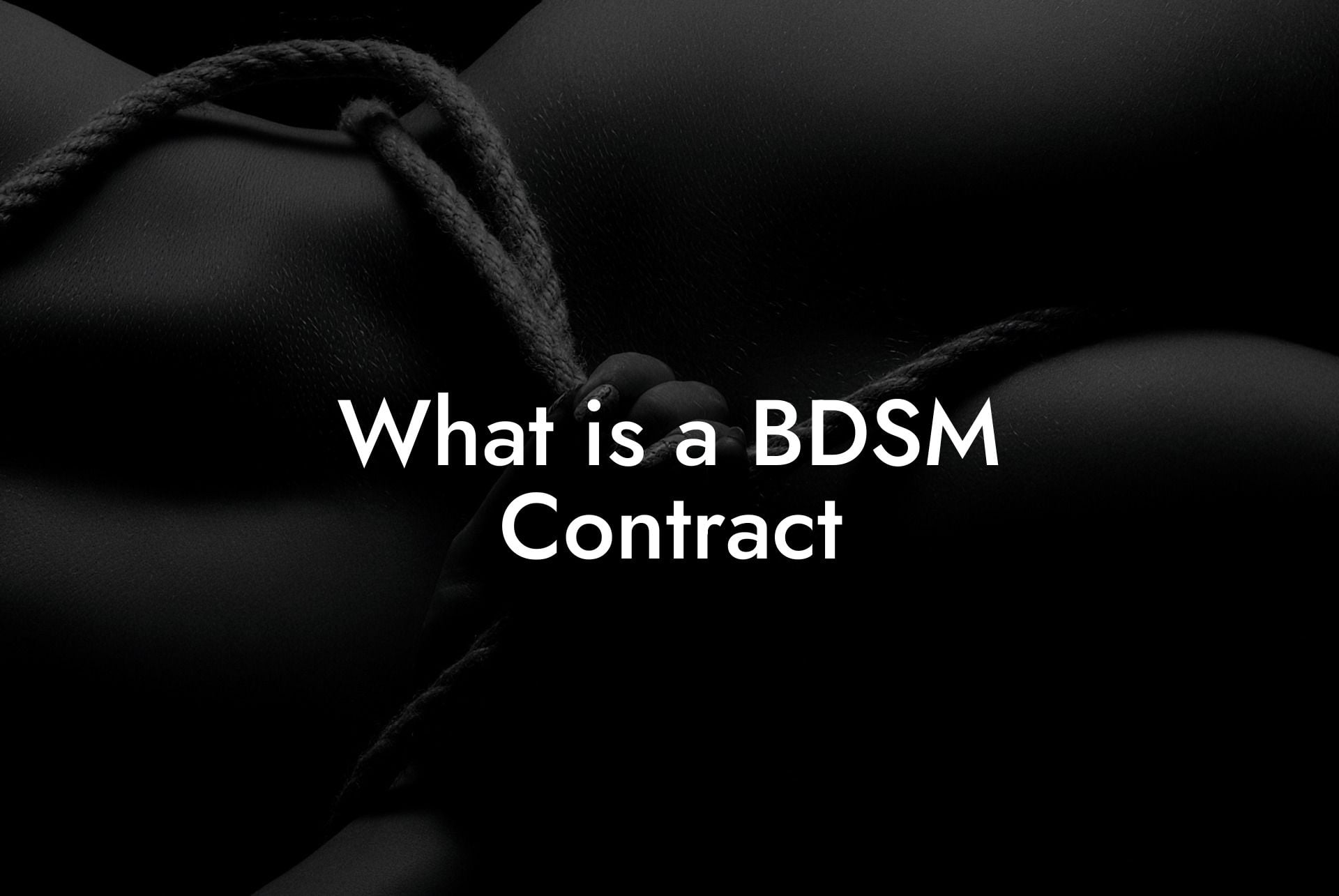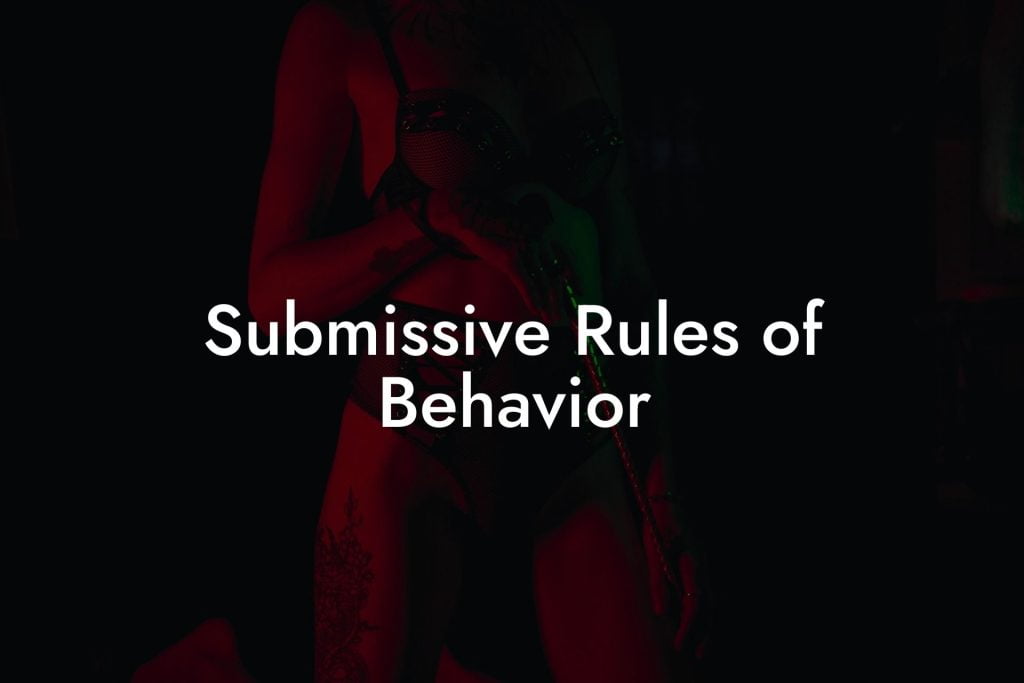In the fascinating world of BDSM, where boundaries are pushed, desires are explored, and power dynamics are embraced, a BDSM contract plays a pivotal role in setting the foundation for a consensual power exchange. But what exactly is a BDSM contract? In this article, we will dive deep into understanding this powerful document and its significance within the realm of BDSM.
1. The Purpose and Importance of a BDSM Contract
- Defining the power dynamics: A BDSM contract serves as a mutual agreement between consenting parties, outlining the roles, responsibilities, and limits of each participant.
- Establishing trust: By openly discussing desires, expectations, and boundaries, a BDSM contract promotes trust and ensures that all parties involved are on the same page.
- Negotiating consent: The contract allows individuals to negotiate terms and parameters for various activities, ensuring that consent is informed, ongoing, and enthusiastic.
- Protecting all parties: A BDSM contract can provide a sense of security by clearly stating safety protocols, hard limits, and emergency procedures. It acts as a safeguard against potential misunderstandings or harm.
2. Components of a BDSM Contract
- Introduction: This section typically includes a brief overview of the purpose of the contract, the parties involved, and their individual roles (such as Dominant and submissive).
- Consent and limits: Here, participants outline their consent and establish hard and soft limits – activities they are comfortable with and those they prefer to avoid.
- Hard limits: Clearly defined activities or actions that are completely off-limits to all parties involved.
- Soft limits: Activities that participants may be willing to explore further under specific circumstances or after proper negotiation.
- Safewords: Safewords act as a verbal or non-verbal signal to pause or stop activities during play if someone becomes uncomfortable or the situation becomes unsafe.
- Duration and termination: This section establishes the duration of the contract and outlines the process for renegotiating, renewing, or terminating the agreement.
- Confidentiality: Respecting the privacy and confidentiality of all involved is crucial, and this section ensures that sensitive information remains protected.
- Consent revocation: A clear statement granting the right to revoke consent at any time, emphasizing the ongoing nature of consent within BDSM dynamics.
What is a BDSM Contract Example:
To better understand the concept in a practical scenario, let's consider a fictional example. Emily and James, two consenting adults, decide to explore BDSM together. They sit down and draft a contract after multiple discussions. In their contract, they establish James as the Dominant and Emily as the submissive. They outline their limits, desires, and specific activities they wish to explore, such as bondage, sensation play, and role-playing. They also establish a safeword, "Red," to be used if Emily ever needs to stop the scene immediately. The contract is set to last for six months, after which they plan to renew and discuss any necessary modifications.
Frequently Asked Questions
What is a BDSM contract?
A BDSM contract is a written agreement between consenting parties in the BDSM community that outlines the expectations, roles, limits, and responsibilities of each participant. It serves to create a mutual understanding and to enhance communication around their power-exchange dynamics.
Why might someone choose to use a BDSM contract?
Individuals may choose to use a BDSM contract to establish clear boundaries and rules for their interaction. This can provide a sense of security and trust, as it ensures all parties understand and consent to the activities that will, and will not, take place.
Are BDSM contracts legally binding?
While BDSM contracts can be a useful tool for negotiation and clarity, they are not recognized by most legal systems as a binding agreement. They are typically considered more symbolic and personal than legal documents.
What are common components of a BDSM contract?
Common components of a BDSM contract include terms of confidentiality, limits and boundaries, safewords, duration of the contract, expectations regarding behavior, aftercare, and any relevant protocols or rituals.
How do power dynamics work in a BDSM relationship?
Power dynamics in BDSM involve an exchange of control where one person (the dominant) takes more control and the other person (the submissive) gives up control, within the limits and boundaries they have discussed and agreed upon.
Can the terms of a BDSM contract be renegotiated?
Yes, a BDSM contract is not set in stone and should be revisited regularly to ensure it continues to reflect the desires, limits, and circumstances of all involved. Open communication is key for renegotiation.
What is consent in the context of BDSM?
Consent in BDSM is the informed, enthusiastic, and ongoing agreement to pursue certain acts or power dynamics. It is not a one-time discussion but a continuous conversation where all parties feel comfortable and enthusiastic about participating.
Why is trust important in BDSM?
Trust is fundamental in BDSM because participants are often engaging in vulnerable and risk-aware activities that require a deep level of confidence in each other's respect for boundaries, agreements, and well-being.
How can a BDSM relationship ensure safety?
Safety in a BDSM relationship can be ensured through thorough negotiation, clear communication, education about the practices involved, adherence to consensually agreed-upon limits, and the use of safewords or signals to halt activity.
What are safewords, and how are they used?
Safewords are pre-negotiated words or signals used to communicate the need to pause, adjust, or stop a scene immediately. They are a crucial part of maintaining consent and safety in BDSM play.
How can you negotiate a scene that satisfies all parties?
Negotiating a scene involves open and honest communication about desires, expectations, limits, and aftercare needs. It's essential for all parties to feel heard and understood for a scene to be mutually satisfying.
What is aftercare, and why is it important?
Aftercare refers to the attention and care given to partners after a BDSM scene, addressing both physical and emotional needs. Aftercare is critical as it helps to ground the participants and reaffirm their respect for one another following the intensity of a scene.
Can anyone practice BDSM, or are there prerequisites?
Anyone interested in BDSM can explore it, but it is important to be educated, open-minded, and have a clear understanding of consent, trust, and communication. A willingness to learn and grow with your partners is also crucial.
What if my limits are different from my partner's in BDSM?
Having different limits from your partner is common in BDSM. It's crucial to engage in open, non-judgmental discussion to find common ground or agreeable compromises while always respecting hard limits.
Is it normal to feel unsure about including BDSM in my relationship?
Feeling unsure is entirely normal, as BDSM involves a range of emotions, trust, and vulnerability. Take the time to research, discuss, and gradually explore what might work best for your relationship.
How do privacy and discretion play a role in BDSM contracts?
Privacy is greatly valued in BDSM, as activities often involve personal aspects of an individual's life. Discretion clauses within contracts help to protect the identities and personal lives of those involved outside of their BDSM interactions.
What should I do if a boundary is crossed during a BDSM scene?
If a boundary is crossed, use your safeword or signal immediately to stop the activity. After the scene's end, it is critical to communicate about what happened, why the boundary was crossed, and how to avoid similar situations in the future.
Are there certain red flags to look out for in a potential BDSM partner?
Red flags include a partner who refuses to discuss limits, ignores safewords, pressures you into activities you are uncomfortable with, or does not prioritize your safety and consent. Trust your instincts, and prioritize your well-being.
How do I approach aftercare if I'm inexperienced?
If you're inexperienced with aftercare, communicate with your partner about their needs and preferences. Common practices include providing comfort, hydration, blankets, quiet company, or sometimes discussion about the scene.
Is BDSM exclusive to romantic relationships?
BDSM is not exclusive to romantic relationships; it can be a part of any consenting adult relationship, including friendships, partnerships, or professional dynamics, as long as it's safe, sane, and consensual.
How can I be a responsible member of the BDSM community?
To be responsible within the BDSM community, prioritize consent, honest communication, respect for boundaries, continuous education, and engage in community-led initiatives, discussions, and events to promote a culture of safety and openness.
Where can I find more information on BDSM practices and safety?
More information on BDSM can be found through local community workshops, online forums, reputable books, certified sex educators, and organizations dedicated to BDSM education and safety advocacy.
Now that you have a solid grasp of what a BDSM contract entails, consider exploring our Ultimate BDSM Contract Pack, which provides a comprehensive template to help you establish your own agreement. Additionally, don't forget to browse our Filthy Adult blog for more informative guides on the diverse world of BDSM and kink. If you're looking to spice up your play sessions, our fetish shop offers a wide range of tantalizing products. Share this article with fellow kink enthusiasts to spread awareness about the importance of consensual power dynamics within the BDSM community.
(Note: This is a fictional brand and content developed purely for demonstration purposes. The content contains explicit themes.)













